Introduction to Web and Database Concepts
23 Pages2946 Words59 Views
Added on 2022-12-15
About This Document
This document provides an introduction to web and database concepts. It covers topics such as entity relationship diagrams, relational databases, and normalization. It also explores the relationship between different database tables and provides guidance on developing a relational database. The document includes examples and calculations to help readers understand the concepts better.
Introduction to Web and Database Concepts
Added on 2022-12-15
ShareRelated Documents
Introduction-to-Web-and-Database-
Concepts
1
Concepts
1

Contents
INTRODUCTION...........................................................................................................................3
TASK...............................................................................................................................................3
Entity relationship Diagram-.......................................................................................................3
Develop a relational database-.....................................................................................................6
CONCLUSION..............................................................................................................................22
REFERENCES..............................................................................................................................23
2
INTRODUCTION...........................................................................................................................3
TASK...............................................................................................................................................3
Entity relationship Diagram-.......................................................................................................3
Develop a relational database-.....................................................................................................6
CONCLUSION..............................................................................................................................22
REFERENCES..............................................................................................................................23
2
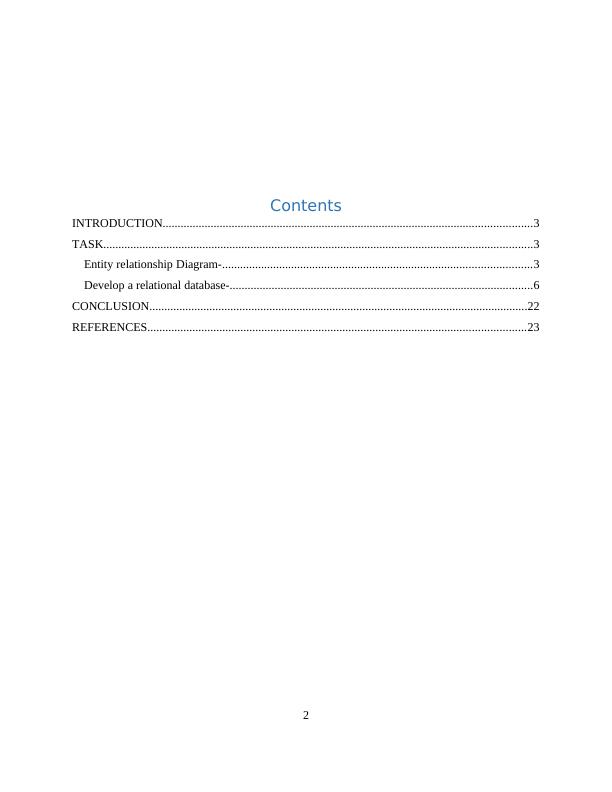
INTRODUCTION
Database is based on the collection of data or information that organise into structured forms
within database management system. There are huge amount of data stored in DBMS in the form
of tables. In this report, it is mainly focused on the Celtic Catering management system that
provide the various kind of food product as well as service to their potential consumers.
Therefore, it will develop a database system for catering business in which performed the
different tasks in proper manner. The business will try to upgrade their entire business data
processing provision and help for running of their catering service. in order to improve the
financial status of organisation.
This documentation will describe about the Entity relationship diagram and also showing
entities, relationship, and membership class, other kind of annotated description of each
relationship. Moreover, it will create database tables by using SQL queries in MS Access,
creating a suitable foreign key to establish a relationship between one or more tables.
Furthermore, it will produce a calculation in report and create embedded forms, report from
macro query, also displaying the menu after database opens.
TASK
Entity relationship Diagram-
An entity relationship Diagram is based on graphical representation that provides a snapshot of
how different entities relate to each other. Sometimes, it is also known as blueprint that
underpins of entire business architecture, offering a visual representation of relationship between
different set of data such as entities (Aggarwal, Winstead and Tufte, 2020). Before developing a
database, it is important to understand the conceptual termed because it stores a large amount or
data. Moreover, it is also impact on the business that needs to store data such as customer,
product, order, staff member and manager, payment etc.
3
Database is based on the collection of data or information that organise into structured forms
within database management system. There are huge amount of data stored in DBMS in the form
of tables. In this report, it is mainly focused on the Celtic Catering management system that
provide the various kind of food product as well as service to their potential consumers.
Therefore, it will develop a database system for catering business in which performed the
different tasks in proper manner. The business will try to upgrade their entire business data
processing provision and help for running of their catering service. in order to improve the
financial status of organisation.
This documentation will describe about the Entity relationship diagram and also showing
entities, relationship, and membership class, other kind of annotated description of each
relationship. Moreover, it will create database tables by using SQL queries in MS Access,
creating a suitable foreign key to establish a relationship between one or more tables.
Furthermore, it will produce a calculation in report and create embedded forms, report from
macro query, also displaying the menu after database opens.
TASK
Entity relationship Diagram-
An entity relationship Diagram is based on graphical representation that provides a snapshot of
how different entities relate to each other. Sometimes, it is also known as blueprint that
underpins of entire business architecture, offering a visual representation of relationship between
different set of data such as entities (Aggarwal, Winstead and Tufte, 2020). Before developing a
database, it is important to understand the conceptual termed because it stores a large amount or
data. Moreover, it is also impact on the business that needs to store data such as customer,
product, order, staff member and manager, payment etc.
3
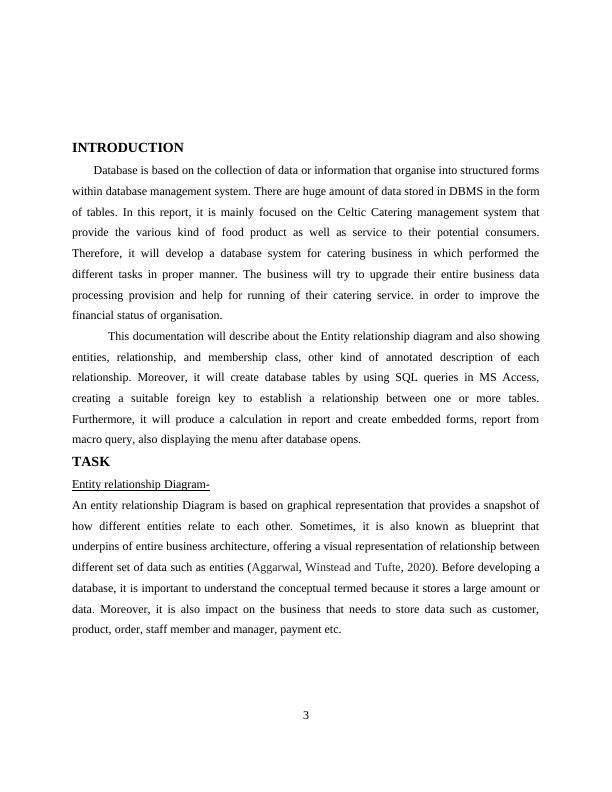
Order Customers Store manager Stores Kitchen Staff
payment Booking Invoices Catering_ServicesEvents
Menu Products ingredients Purchase_Order Suppliers
Order_ID (PK)
Customer_ID (FK)
Payment_ID (FK)
PK
Type _of_Payment
Mode_of_payment
Date
Customer_ID (PK)PK
Name
Address
Tel_No
Manager_ID (PK)
Store_ID (FK)
Order_ID (FK)
PK
Name
Tel_no
Email
Store_ID (PK)PK
Name
Location
address
Tel_No
Staff_ID (PK)
Order_ID ()
PK
Name, Shift
Payment_ID (PK)
Order_ID (FK)
Customer_ID (FK)
PK
Amount
paid, Due
Booking_ID (PK)
Customer_ID (FK)
PK
Location
address
Time
Operations
Invoice_ID (PK)
Order_ID (FK)
Customer_ID (FK)
Event_ID (FK)
Menu_ID (FK)
Booking_ID (FK)
PK
Service_ID (PK)PK
Type_od_Service
Numbrer_od_services
Staff
Event_ID (PK)PK
Type_of_Event
Menu_ID (PK)
Product_ID (FK)
PK
Description
Menu_type
price
Product_ID (PK)
Ingridient_ID (FK)
PK
Name
Ingredient_ID (PK)PK
name
Quantity
Expeiry_date
Purchase_Order_ID (PK)
Supplier_ID (FK)
product_ID (FK)
PK
Order_date
Quantity
Product_name
Paid
Supplier_ID (PK)PK
name
no_of_Suppliers
Items_supplied
Figure 1 Entity Relationship Diagram
Entities- in DBMS, entity is a type of real world object with a suitable existence. For example-
in above ER diagram, Customer, payment, product, staff, manager and order etc. these are all
consider as entities in database system which may support for establishing a relationship between
one or more tables.
Relationships- in ER, A relationship is primarily describe the way in which consists of one more
data sets that are linked with each other (Jovanov, Zdraveski and Gusev, 2020). It allows for user
to share large amount of data set in separate table. It is the best way to utilise link disparate
information with each other.
Degree of Relationships- The degree of relationship is basically defined as number of multiple
occurrences in one entity that is associated with number of occurrences in another entity. In
above table, it has been represented the degree of relationship such as one to one (1:1), one to
many (1: M), many to many (M: M). generally, it should be considered the cardinality, mapping
of entities. It is helping to utilise a table and establish a linked to another table. These are
becoming consider as particularized more as number of distinct values of table connected to how
many of values in another one.
4
payment Booking Invoices Catering_ServicesEvents
Menu Products ingredients Purchase_Order Suppliers
Order_ID (PK)
Customer_ID (FK)
Payment_ID (FK)
PK
Type _of_Payment
Mode_of_payment
Date
Customer_ID (PK)PK
Name
Address
Tel_No
Manager_ID (PK)
Store_ID (FK)
Order_ID (FK)
PK
Name
Tel_no
Store_ID (PK)PK
Name
Location
address
Tel_No
Staff_ID (PK)
Order_ID ()
PK
Name, Shift
Payment_ID (PK)
Order_ID (FK)
Customer_ID (FK)
PK
Amount
paid, Due
Booking_ID (PK)
Customer_ID (FK)
PK
Location
address
Time
Operations
Invoice_ID (PK)
Order_ID (FK)
Customer_ID (FK)
Event_ID (FK)
Menu_ID (FK)
Booking_ID (FK)
PK
Service_ID (PK)PK
Type_od_Service
Numbrer_od_services
Staff
Event_ID (PK)PK
Type_of_Event
Menu_ID (PK)
Product_ID (FK)
PK
Description
Menu_type
price
Product_ID (PK)
Ingridient_ID (FK)
PK
Name
Ingredient_ID (PK)PK
name
Quantity
Expeiry_date
Purchase_Order_ID (PK)
Supplier_ID (FK)
product_ID (FK)
PK
Order_date
Quantity
Product_name
Paid
Supplier_ID (PK)PK
name
no_of_Suppliers
Items_supplied
Figure 1 Entity Relationship Diagram
Entities- in DBMS, entity is a type of real world object with a suitable existence. For example-
in above ER diagram, Customer, payment, product, staff, manager and order etc. these are all
consider as entities in database system which may support for establishing a relationship between
one or more tables.
Relationships- in ER, A relationship is primarily describe the way in which consists of one more
data sets that are linked with each other (Jovanov, Zdraveski and Gusev, 2020). It allows for user
to share large amount of data set in separate table. It is the best way to utilise link disparate
information with each other.
Degree of Relationships- The degree of relationship is basically defined as number of multiple
occurrences in one entity that is associated with number of occurrences in another entity. In
above table, it has been represented the degree of relationship such as one to one (1:1), one to
many (1: M), many to many (M: M). generally, it should be considered the cardinality, mapping
of entities. It is helping to utilise a table and establish a linked to another table. These are
becoming consider as particularized more as number of distinct values of table connected to how
many of values in another one.
4
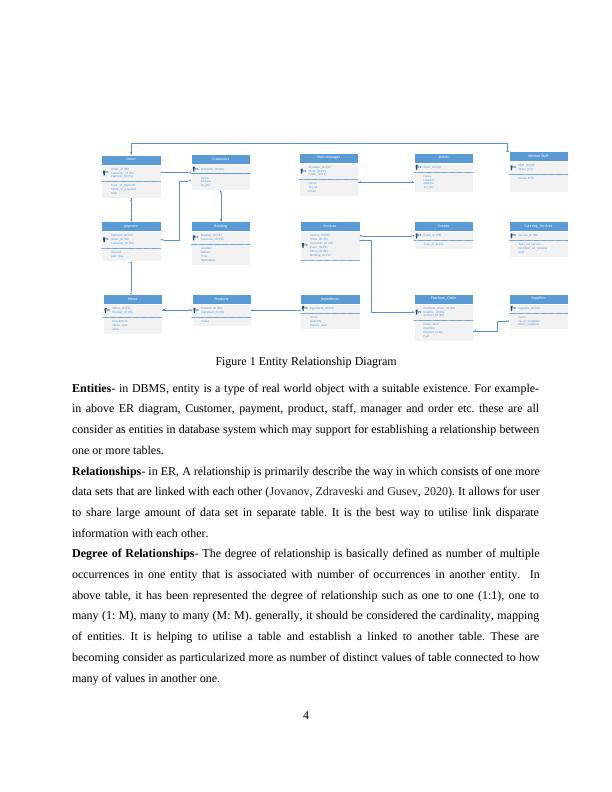
Membership class- It is based on the member class that is declared as non-static members which
contain a class. Sometimes, it is also representing as static member class that is analogous to
field or method.
Entities and their attributes-
Entities Attributes
Customer Customer_id (PK)
Customer_name
Customer_phoneNo
Customer_email
Customer_type
Manager Manager_id (PK)
Manager_name
Manager_contactNo
Order Order_id (PK)
Order_date
Order_time
Order_type
Payment Payment_id (PK)
Payment_status
Payment_amount
Payment_date
Product Product_id (PK)
Product_name
Product_quantity
Product_price
Staff Staff_id (PK)
Staff_name
5
contain a class. Sometimes, it is also representing as static member class that is analogous to
field or method.
Entities and their attributes-
Entities Attributes
Customer Customer_id (PK)
Customer_name
Customer_phoneNo
Customer_email
Customer_type
Manager Manager_id (PK)
Manager_name
Manager_contactNo
Order Order_id (PK)
Order_date
Order_time
Order_type
Payment Payment_id (PK)
Payment_status
Payment_amount
Payment_date
Product Product_id (PK)
Product_name
Product_quantity
Product_price
Staff Staff_id (PK)
Staff_name
5
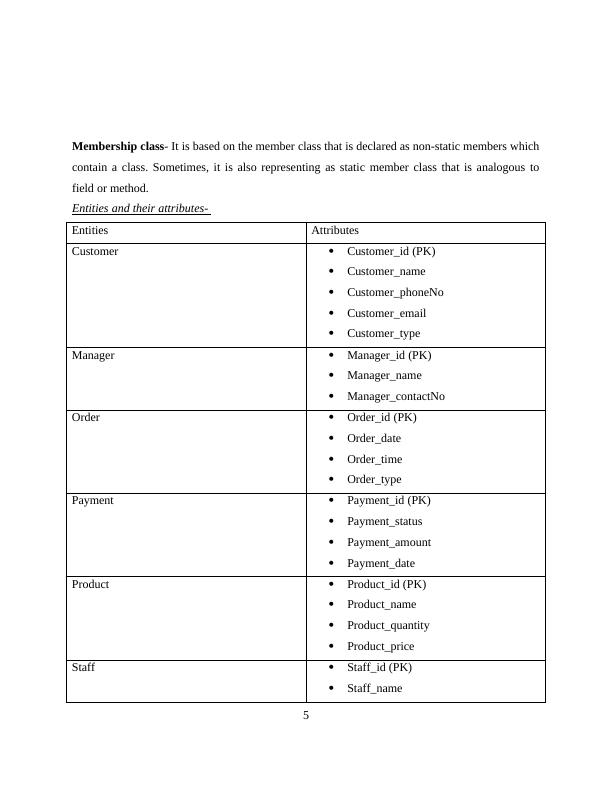
Staff_PhoneNo
Staff_email
Staff_designation
Table: 1
An entity relationship diagram is provided a snapshot of how different entities are related to each
other. it could call as blueprint that underpins the business, offering as important aspect to handle
different tasks.
Develop a relational database-
A database table is mainly contained the collection of related data which held in the form of table
within database (Le, Likhitruangsilp and Yabuki, 2020). In relational database, it is completely
suitable for representing field and rows, cell-being as unit where a row or column intersect in
proper manner.
Database tables-
Customer table
6
Staff_email
Staff_designation
Table: 1
An entity relationship diagram is provided a snapshot of how different entities are related to each
other. it could call as blueprint that underpins the business, offering as important aspect to handle
different tasks.
Develop a relational database-
A database table is mainly contained the collection of related data which held in the form of table
within database (Le, Likhitruangsilp and Yabuki, 2020). In relational database, it is completely
suitable for representing field and rows, cell-being as unit where a row or column intersect in
proper manner.
Database tables-
Customer table
6
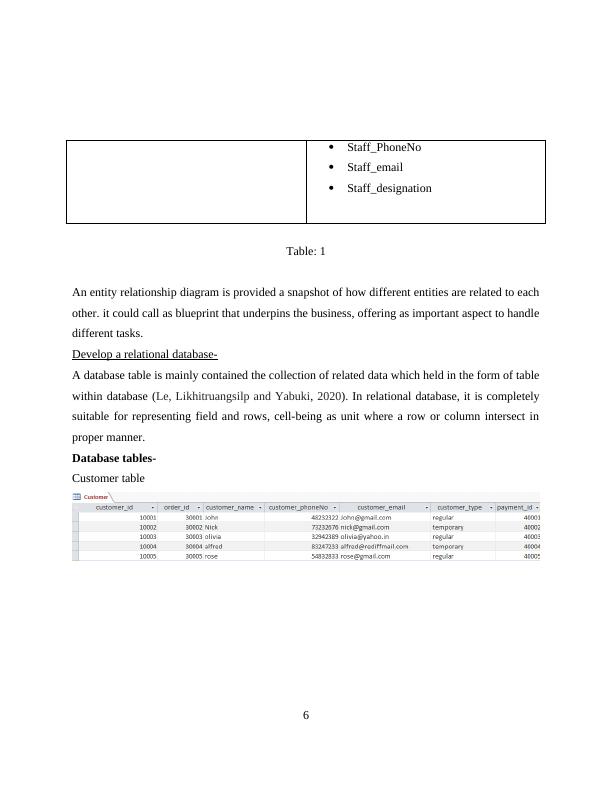
End of preview
Want to access all the pages? Upload your documents or become a member.
Related Documents
Database Design and Developmentlg...
|20
|2372
|2
Database Design and Development for Celtic Catererslg...
|17
|2204
|382
Sales And Marketing Management Database System Assignmentlg...
|28
|1151
|183
Database of Business Rules Entities and Attributeslg...
|20
|2546
|433
Entity Relationship Diagram Assignment 2022lg...
|4
|673
|13
SOFTWARE MODELING AND DESIGN.lg...
|7
|493
|85
